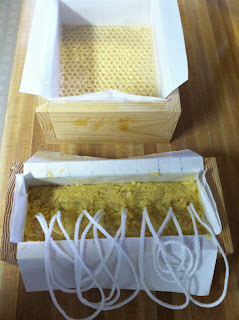I have been wanting to make Soap-On-A-Rope for a long time. I searched online soap making supply companies for the rope parts and found them, but there were super expensive, in my opinion anyway. So I had to find a more cost effective solution.
I found some nylon cording at Hobby Lobby for about $1.99 or $2.99, can't remember exactly, but I was able to use a 40% coupon. Anyway, it came in a lot of colors, but I thought basic white was the best choice, because it would go with anything. Also it was about 2 miles long, so I'll have nylon rope for lots of future projects.
I used my basic bath soap recipe and scented it for men, using leather, sandalwood, and vanilla fragrance oils, and cedar essential oil. I didn't add any color because the fragrance oils tend to darken the soap batter.
I measured and marked on the liner paper where the bars would be cut so that would know where to place the ropes.
I cut the ropes into what I thought were good lengths and slightly melted the ends and stuck them together. I used a knife to push the ropes down into the soap batter. I made a two pound batch of soap and got 8 bars.
I also made a batch of Goat's Milk, Honey and Oatmeal Soap to give away. The family members who live further away had never tried my soap so I sent some of this, along with Charcoal, Tea Tree and Lavender Face Soap.
The goat's milk soap is made differently from the first one. It is what is known as "cold process" as opposed to the soap on a rope recipe, which is "hot process". Hot process means it is cooked until the oils and lye have saponified and excess water is cooked out. That type of soap is ready to use right away. That's the way great-grandma probably did it, in a cast iron kettle over an open fire.
Nowadays, we use a crock pot.
Cold process soap is mixed and poured into molds right after it reaches "trace" (the point where the saponification process is taking place). The excess liquid has to evaporate over time - usually 4-6 weeks.
Goat's milk can cook when it is mixed with the lye, turning it brown, so I freeze the milk and mix it with the lye while frozen. This eliminates the dark color. I added local Ozark honey and finely blended organic oatmeal. to this soap. There is no fragrance or color of any kind in this soap. The honey tends to turn it a more golden color (due to the sugar). I used only a one pound recipe, which turned out to not be enough to my liking, because the bars turned out thin. I lined the mold with bubble wrap, top and bottom, to give the soap a honeycomb look after unmolding.
 |
| Soap covered with bubble wrap |
Below is a pic of my work space. This is the kitchen in the "Little House". The only problem with this house is that there is a floor joist that needs to be replaced and some rotted floor boards too and the floor has a "buckle" in it in the kitchen. Some day I'll get around to fixing it.... but for now it works just fine for all my crafty projects.
Not shown in the pic: Canning jars and equipment are stored in the cabinets and pantry. We use this kitchen for butchering, so butcher paper, tape, a commercial meat cutter, saws, etc. are located here, as are the four freezers belonging to the kids (mine is in my house). There's a wooden work table in the middle of the room. I cover the top with freezer paper for soap making. We also have a "plastic" folding table that we use for butchering. I also have my soap supplies located here. This is a perfect place to do these types of activities, because I don't have to worry about lye in the house and I can walk out and leave the mess for another day!























